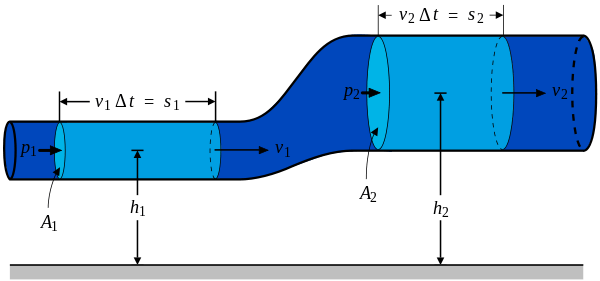Clausius–Duhem inequality
| Continuum mechanics | ||||
|---|---|---|---|---|
 | ||||
|
Laws
|
||||
The Clausius–Duhem inequality[1][2] is a way of expressing the second law of thermodynamics that is used in continuum mechanics. This inequality is particularly useful in determining whether the constitutive relation of a material is thermodynamically allowable.[3]
This inequality is a statement concerning the irreversibility of natural processes, especially when energy dissipation is involved. It was named after the German physicist Rudolf Clausius and French physicist Pierre Duhem.
Clausius–Duhem inequality in terms of the specific entropy
The Clausius–Duhem inequality can be expressed in integral form as
In this equation is the time, represents a body and the integration is over the volume of the body, represents the surface of the body, is the mass density of the body, is the specific entropy (entropy per unit mass), is the normal velocity of , is the velocity of particles inside , is the unit normal to the surface, is the heat flux vector, is an energy source per unit mass, and is the absolute temperature. All the variables are functions of a material point at at time .
In differential form the Clausius–Duhem inequality can be written as
where is the time derivative of and is the divergence of the vector .
| Proof |
|---|
| Assume that is an arbitrary fixed control volume. Then
and the derivative can be taken inside the integral to give Using the divergence theorem, we get Since is arbitrary, we must have Expanding out or, or, Now, the material time derivatives of and are given by Therefore, From the conservation of mass . Hence, |
Clausius–Duhem inequality in terms of specific internal energy
The inequality can be expressed in terms of the internal energy as
where is the time derivative of the specific internal energy (the internal energy per unit mass), is the Cauchy stress, and is the gradient of the velocity. This inequality incorporates the balance of energy and the balance of linear and angular momentum into the expression for the Clausius–Duhem inequality.
| Proof |
|---|
| Using the identity
in the Clausius–Duhem inequality, we get Now, using index notation with respect to a Cartesian coordinate system , Hence, From the balance of energy Therefore, Rearranging, |
Dissipation
The quantity
is called the dissipation which is defined as the rate of internal entropy production per unit volume times the absolute temperature. Hence the Clausius–Duhem inequality is also called the dissipation inequality. In a real material, the dissipation is always greater than zero.
See also
References
- ↑ Truesdell, Clifford (1952), "The Mechanical foundations of elasticity and fluid dynamics", Journal of Rational Mechanics and Analysis, 1: 125–300.
- ↑ Truesdell, Clifford & Toupin, Richard (1960), "The Classical Field Theories of Mechanics", Handbuch der Physik, III, Berlin: Springer.
- ↑ Frémond, M. (2006), "The Clausius–Duhem Inequality, an Interesting and Productive Inequality", Nonsmooth Mechanics and Analysis, Advances in mechanics and mathematics, 12, New York: Springer, pp. 107–118, doi:10.1007/0-387-29195-4_10, ISBN 0-387-29196-2.
External links
- Memories of Clifford Truesdell by Bernard D. Coleman, Journal of Elasticity, 2003.
- Thoughts on Thermomechanics by Walter Noll, 2008.